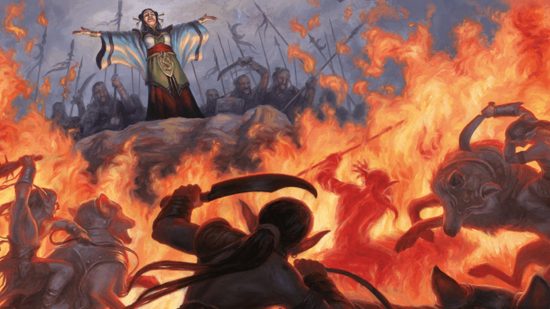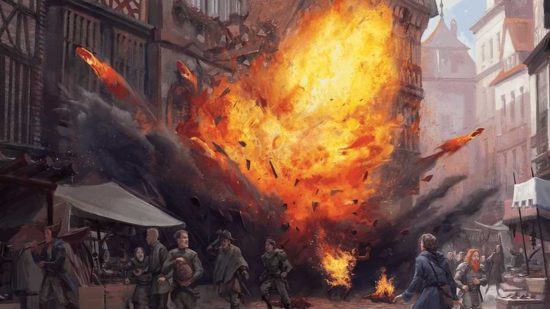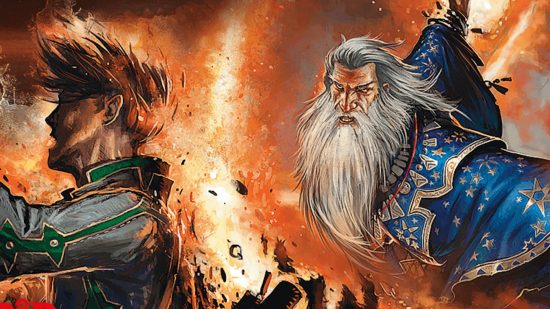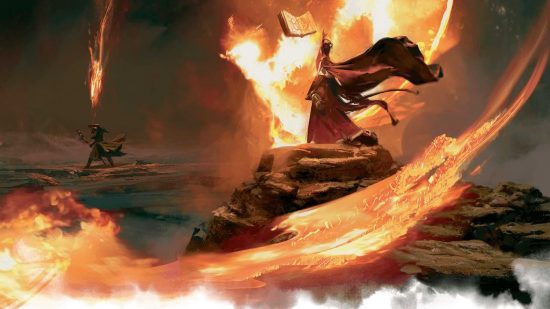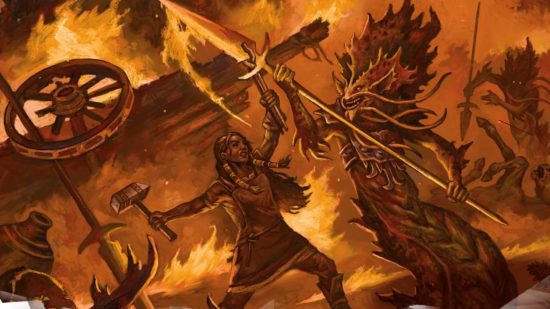The DnD Wall of Fire 5e spell stands out as one of the flashiest ways to heat up a battle. While it may not have the simple yet destructive impact of a Fireball, Wall of Fire offers some unorthodox ways to burn down opponents, especially with a well-organized party. This guide explains how Wall of Fire works, which classes can cast it, and how to use it most effectively.
If you want to tailor your DnD character build around Wall of Fire, we have separate guides to DnD classes and DnD races that will help you to find the perfect synergies.
Wall of Fire will floor players who see it in action for the first time. A large swath of flaming pillars ascends from the ground, daring any who come near to pass through. More importantly, the Wall of Fire keeps burning for as long as the caster can concentrate on the massive flaming wall they summoned.
Wall of Fire doesn’t have the simplicity of its DnD Fireball cousin. It requires careful planning and position for maximum impact. Ineffectively casting Wall of Fire could result in a spell that grants dramatic lighting to the fight and nothing else.
Here’s everything you need to know about the DnD Wall of Fire 5e spell:
Wall of Fire 5e Features
| Level | Fourth |
| Casting time | One action |
| Duration | Concentration, up to one minute |
| Range | 120 feet |
| Area | A straight wall up to 60′ long, 20′ high, and one foot thick. OR A ringed wall up to 20 feet in diameter, 20 feet high, and 1 foot thick |
| Attack / Save | Dexterity save |
| School | Evocation |
What does Wall of Fire 5e do?
The caster creates a fiery wall on any solid surface within range. Notably, the wall blocks the line of sight of creatures on either side of it. Once the wall materializes, creatures caught in its area must make a Dexterity saving throw. On a failed save, creatures will take 5D8 fire damage and half as much on a successful save.
When the player casts the wall they select one side to bear the brunt of its heat. Creatures that end their turn on that side of the wall and within 10’ of it will suffer 5D8 fire damage, no save allowed. Creatures who enter the wall for the first time on a turn or end their turn within the wall take the same amount of guaranteed damage.
When casting the wall using a higher level spell slot, players add 1D8 fire damage to the spell’s effects for each slot level above fourth.
Who can cast Wall of Fire 5e?
DnD Druids, Sorcerers, and Wizards can cast Wall of Fire. Although Sorcerers and Wizards arguably have “better” pyromancy spells for dealing damage like Fireball and Meteor Swarm, Wall of Fire still has plenty of utility for them. Druids will likely get more use out of Wall of Fire as its utility fits well with the classically support-oriented Druid class.
DnD Sorcerers and Wizards who go all in on the Pyromancy build should include Wall of Fire in their arsenal. After all, Wall of Fire and Fireball aren’t mutually exclusive. Several strategies can open up when the right spells are combined.
Pros and Cons of Wall of Fire 5e
Pros
- Fantastic for splitting enemy hordes apart, especially in dungeons
- The wall will deal guaranteed damage to those caught in its area of effect without any action required
- Blocks line of sight, preventing enemy casters from targeting you when positioned correctly
Cons
- Once cast, the caster cannot reposition the wall unless they cast the spell again.
- Deals significantly less damage in a single instance compared to spells like Fireball
- Loses effectiveness in open areas with no walls
Wall of Fire is a change of pace for trigger-happy pyromancers. Unlike Fireball and Meteor Swarm, which offer instant fiery gratification, Wall of Fire won’t usually clear out hordes in a single turn. However, the crowd control aspect of Wall of Fire makes it a great asset against hordes of weaker enemies.
With the proper positioning, the guaranteed damage makes Wall of Fire a solid damage dealer for the rest of the fight, and high-Dexterity enemies have no way to avoid the damage. But if you position it wrong, and create an easily avoidable firewall, you’ll waste a fourth level spell slot.
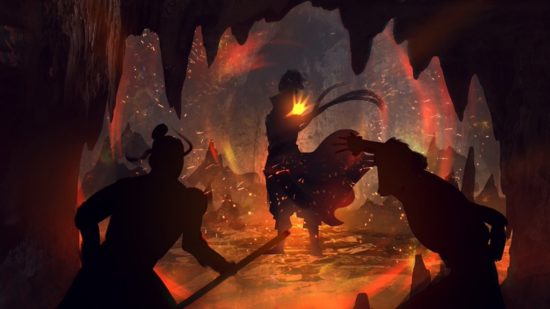
Best Strategies for Wall of Fire 5e
Wall of Fire shines best in dungeons and other indoor areas. Take, for example, a cave with a group of twenty goblins against your party of five. The goblins can only reach the players via a single, narrow corridor. Wall of Fire guarantees that every goblin that goes through that corridor will take fire damage.
If a straight corridor is 11’ wide or narrower, you can position the Wall of Fire along one corridor wall, with the fire damage directed into the corridor. The entire corridor is now a pressure cooker that will burn anything that enters, but your ranged attacks down the corridor will be unimpeded.
Knockback spells like Gust of Wind or the Warlock’s Repelling Blast can push enemies back into the flames. Martial classes can use their physical abilities to do the same. Rogues can throw oil bottles in the corridor to extend the fire further. That alone makes Wall of Fire excellent for controlling chokepoints.
Alternatively, the ringed wall variant of Wall of Fire can trap foes in a lethal spell combo. This is great when your party has locked a group of enemies in place with a spell like Entangle: cast a ringed Wall of Fire around them to deal constant fire damage to those within. Any casters within the ringed Wall of Fire cannot cast DnD Counterspell 5e against you since the wall blocks their line of sight.
After more mean spellcasting tricks? Check out our guides to the DnD Wizard 5e class, the other DnD Wizard spells that you can use your other spell slots on, and the DnD Tiefling 5e race, nature’s arsonists.
